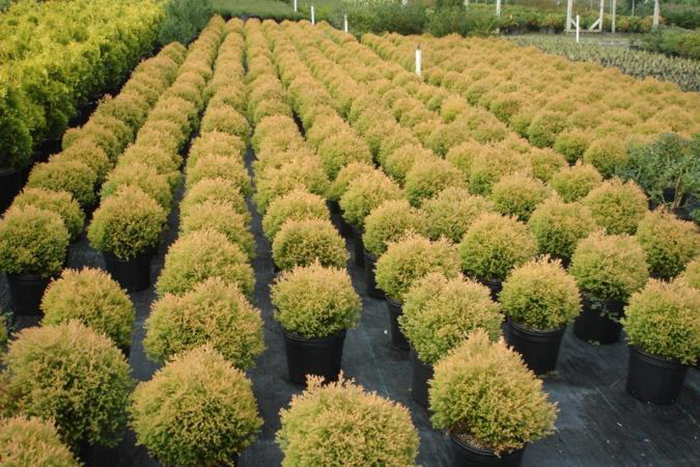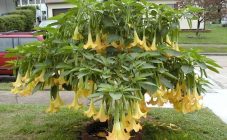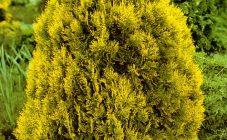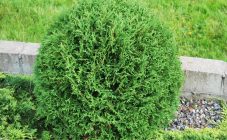Content:
Landscape designers are increasingly using various varieties of tui in their work. And this is not surprising: these evergreen beauties delight with their beauty all year round.
Plant characteristic
Thuja is an evergreen tree or shrub of the Cypress family. Under natural conditions, the tree grows up to 20 m in height, in urban conditions its height rarely reaches 11 m. Although these beautiful plants do not have flowers, they are very decorative due to the various shapes and colors of the needles. Depending on the variety, the crown of thuja can grow in the form of a cone or a ball, and the color range is light green, dark green, blue, aqua, yellow.
Thuja Reingold: description
The main difference in the characteristics of this variety will be the special color of its needles. The bright yellow thuja Reingold, planted against the background of green plants, acts as a tapeworm in the garden. In winter, the needles acquire a bronze tint.
This is a dwarf-shaped western thuja variety. The crown of this tree changes shape throughout the entire life cycle: at first it is cushion or spherical, in the process of growth it stretches and takes the shape of a cone. It grows slowly, no more than 10 cm per year, in 10 years it grows up to 1 m. The maximum tree height is 3 m. The branches are thin, soft leaves have the shape of scaly needles.
Landing
It is preferable to choose light, peaty soils with an admixture of sand. If the site contains heavier soil, then a drainage layer of about 20-30 cm should be poured onto the bottom of the planting pit. Ideal as drainage: crushed stone of the middle fraction or broken brick. The soil mixture is prepared by mixing the following components:
- sand - 1 part;
- peat - 1 part;
- sod land - 2 parts.
The planting hole is dug about a meter wide and about 60-80 cm deep. The placed seedling is best covered with a nutrient mixture that was used for drainage. So that the plant takes root and grows well, it does not hurt to add nitroammophos.
Care
In order for a tree to grow and develop well, it needs to be taken care of. Care includes the following procedures:
- Top dressing. Like many other garden plants, thuja western Reingold will respond well to organic and mineral fertilizers.
- Regular watering: at least one bucket, once a week (nevertheless, at home, this plant is located along the banks of rivers and lakes). Sprinkling on hot sultry days will not be superfluous.
- To retain moisture in the soil, it is necessary to mulch the soil near the trunk with grass, hay, straw or chopped bark and needles.
- Preparing for the winter. The root system of these plants is located on the soil surface and may not be able to cope with the weight of a snow-covered tree. Therefore, for the winter period, it is necessary to shorten the branches of the tree - this will not harm the tree at all, but only make the main branches stronger and the crown thicker. There is another way: the branches of the plant are pulled together with a tape and the plant itself is covered from frost with a covering material.
- Pruning.In spring, damaged and dried shoots are removed.
Diseases and pests
The most common thuja diseases are:
- Fungus. It manifests itself in the form of dark spots, which are most often located on young shoots. If found, it is necessary to remove the affected areas and treat the plant with antifungal drugs.
- Drying of shoots due to a lack of nutrients. Shoots dry up and fall off. It is necessary to fertilize with fertilizers containing copper and iron.
Pests that pose a danger to thuja:
- Tuvaya false shield is a small insect that looks like a shield. When damaged by a false shield, the plant becomes pale, yellow spots appear. For treatment, it is necessary to treat the thuja with any broad-spectrum insecticide.
- Speckled moth. Brown spots form on the branches of the plant, which grow rapidly. The top of the tree dies off. When this pest appears, the tree must be immediately treated with preparations containing pyrethroid.
- Thuvaya aphid. This insect settles on the needles, sucks the juices out of them, as a result of which the needles quickly crumble. If you do not start treatment on time, the plant may die. It is also treated with insecticides.
Use in landscape
Thu western Rheingold is planted as a hedge that can be trimmed to create different shapes. Can be planted in separate groups, combining different colors of other trees and bushes, or can be planted singly. This golden miniature tree looks great in a strictly thought out landscape. This thuja can be used in the design of alpine slides. Due to the fact that this coniferous shrub tolerates cutting well, it will perfectly fit into Japanese-style design.
Beneficial features
In addition to the fact that thuja Reingold is very beautiful, it also (as well as all its relatives) has useful properties. It contains a large amount of essential oils that are used in medicine and perfumery. In medicine, oils are used to fight viral, bacterial and fungal diseases.
Alcohol tincture of pine needles is used in the treatment of prostatitis and cystitis, as well as prostate adenoma. It is used to remove corns, warts and papillomas. Tincture preparation: 3 tbsp. l. Pour the chopped needles with a glass of alcohol. Insist for two weeks, shaking daily. Store in a dark place. The needles are also used to remove corns, warts and papillomas.
By planting this plant in his garden, the gardener will receive great benefits. Thuja will cleanse the air in the area from harmful impurities and will exude a pleasant aroma.















